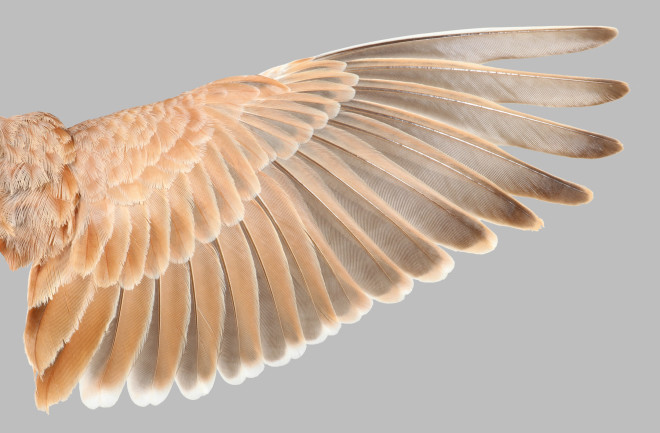Heaps of dinosaurs had feathers. But only a handful developed those feathers for flight. In fact, determining which feathered dinos flew and which feathered dinos didn’t has historically posed a problem for paleontologists. A new study, however, suggests that the problem isn’t as tricky as previously thought.
In the study, published in PNAS, a pair of paleontologists present an assortment of traits that they say all feathers built for flight share. Based on the feathers of the only surviving descendants of the dinosaurs — birds — these traits could clarify which dinosaurs developed the ability to fly, and when.
“Theropod dinosaurs, including birds, are one of the most successful vertebrate lineages on our planet,” said Jingmai O’Connor, one of the study authors and a paleontologist at the Chicago Field Museum, in a press release. “One of the reasons that they’re so successful is their flight. One of the other reasons is probably their feathers, because [they’re] such versatile structures. So any information that can help us understand how these two important features co-evolved [...] is really important.”
Read More: Conventional Wisdom Was Wrong About Dinosaur Feathers
Feathers, Flight, and Becoming Birds
Not all dinosaurs developed feathers and not all dinosaurs developed flight, but some dinosaurs from the theropod family did both. While the bulk of the family, including the tyrannosaurs and the velociraptors, broke out in feathers with their feet firmly planted, a small subset of the theropods developed feathers that took them to the skies some 230 million years ago. (It was among these feathered, flying beasts that the first birds became birds.)
Of course, paleontologists can’t simply stare outside their windows to see which ancient dinosaurs developed feathers for flight. Instead, they usually search for clues in the theropods’ fossils — including the size and shape of their arm bones, wing bones, and wishbones — to determine which feathered dinosaurs were also flying ones.
In the recent study, O’Connor and Yosef Kiat, another paleontologist at the Chicago Field Museum, instead turned to the structure of feathers in birds — the only surviving descendants of the dinosaurs and the only surviving theropods in the world today. By investigating the distribution of their feathers and other feathery features, the pair found several traits that all flying birds seem to share.
According to the team, these traits trace back to the birds’ ancient ancestors — appearing in the fossilized feathers of flying theropods — and thus function as an indicator of which feathered dinosaurs flew and which feathered dinosaurs didn’t.
Read More: Did All Dinosaurs Have Feathers?
What’s Different Between Flying and Non-Flying Feathers?
To arrive at their findings, the team studied feathers from over 340 species of flying and non-flying birds, from pelicans to penguins. Comparing and contrasting the feathers of the fliers with those of the non-fliers, the team identified several shared traits among the species of birds that soar through the skies.
For instance, the primary feathers along the tips of a bird’s wings are always asymmetrical in birds that fly and symmetrical in birds that don’t fly, according to the paleontologists. And, in addition to the distribution of feathers, the pair found that the number of primary feathers in flying birds is always between 9 and 11, while the number of primary feathers in non-flying birds is all over the place — anywhere from 0 to over 40.
“They all share this trait of having between 9 and 11 primary feathers,” said Kiat in a press release. “I was surprised that no one seems to have found this before.”
Read More: Small Dinosaurs May Have Flashed Their Feathers to Scare Prey
Why Are Flying and Non-Flying Feathers So Important?
Testing their findings further, O’Connor and Kiat identified the flying abilities of 35 separate species of fossil theropod, thanks to their set of shared feather traits.
“You can basically look at the overlap of the number of primary feathers and the shape of those feathers to determine if a fossil bird could fly, and whether its ancestors could,” O’Connor said in a press release.
Assessing the fossil theropods Archaeopteryx and Microraptor, for instance, they found that both possessed between 9 and 11 primary feathers, asymmetrical and fitted for flight. Alternatively, they found that Caudipteryx possessed 9 primary feathers in a symmetrical arrangement, suggesting that the theropod stayed terrestrial.
According to the team, the findings could solve some of the most important mysteries about dinosaur feathers and flight. “There have been debates about whether flight evolved in dinosaurs just once, or multiple separate times,” O’Connor said in a press release. “Our results here seem to suggest that flight only evolved once in dinosaurs, but we have to really recognize that our understanding of flight in dinosaurs is just beginning.”
Read More: What Makes Archaeopteryx Fossils the Bizarre Bridge Between Dinos and Birds?
Article Sources
Our writers at Discovermagazine.com use peer-reviewed studies and high-quality sources for our articles, and our editors review them for accuracy and trustworthiness. Review the sources used below for this article:
PNAS. Functional constraints on the number and shape of flight feathers
Current Biology. Feathered dinosaurs
Britannica. Theropod
Britannica. Tyrannosaur
Britannica. Velociraptor
Britannica. Archaeopteryx

